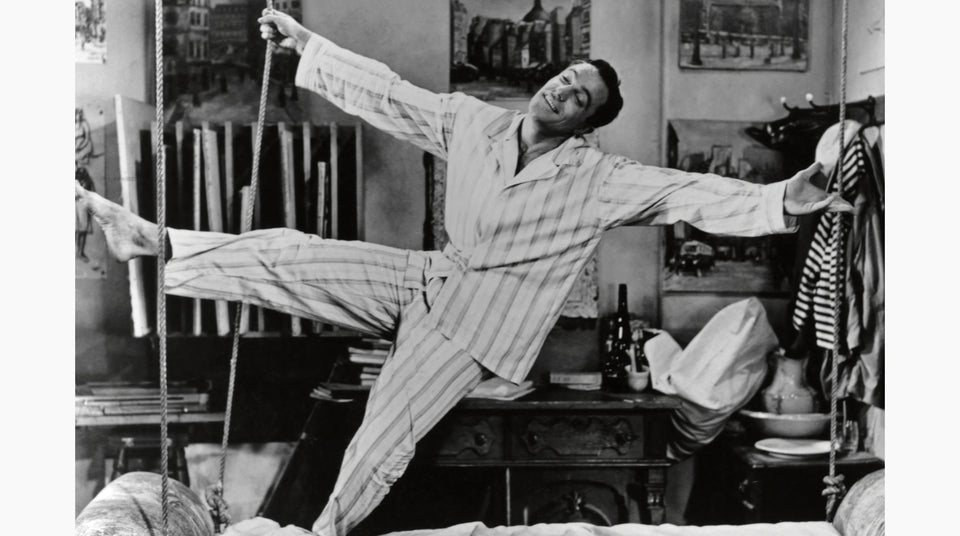Privacy & Publicity: On Pyjamas & Robes

There’s a rather amusing yet prophetic scene in the third season of Downton Abbey. It’s 1918, and the Earl Of Grantham is making polite talk in the dining room. “I nearly came down in a dinner jacket tonight”, he remarks in his starched and formal white tie and tails ensemble. “Really? Why not a dressing gown? Or better still pyjamas”, his mother, the Dowager Countess, played with some aplomb by Dame Maggie Smith, retorts with one of her trademark acidic barbs.
If the Dowager Countess had had her finger on the pulse, she might have noticed there was indeed a quiet revolution underway in the way men were dressing and presenting themselves. Since the tail end of the last century, the fin-de-siecle Aesthetes following the charge of Oscar Wilde were daring to appear in public in silks, velvets and the soft easy tailoring a man donned in his parlour, bedroom or bathroom. Edward “Bertie” Windsor’s adoption of the black tie “Dining Suit” around the same time owes a lot to this radical relaxation in dress codes.
The idea of what a man should wear in the privacy of his own home started to codify and take shape around the same time as what he wore to 'work' in. In the 17th century as the trade routes to the east opened up, European men of means took inspiration from the Sultans and Mandarins of the Orient, and a real distinction between clothing worn for business and clothing worn for pleasure took hold. This new relaxed dress code for one’s private pastimes assumed an implied decadence. Away from prying eyes, men in their homes, clubs or bathhouses were free to shed the shackles of workaday attire, and dining, bathing & lounging were gifted their own specific wardrobe. Pepys wrote of his love of the new trend for “Banyans”; heavy silk robes that took their names from the Gujarati word for a Hindu merchant, with the diarist electing to hire a particularly sumptuous one in gold Chinese silk for a portrait sitting in 1666. Other interchangeable terms for the garment including “Indian Gowne” or even “Japanese Dress Coat” leave little doubt to where Western gentlemen were finding their inspirations. 'Pyjamas' taking both name and their shape and cut from the loose fitting daily wear of men and women in the Indian subcontinent also became the de facto choice for gentlemen’s loungewear.
By the heady days of the 1920s, the new vogue for healthy living and the idle amusements of the wealthy brought the great and good to the beach resorts of the Mediterranean. “How should one dress in the morning? In pyjamas or dressing gown?” Enquires Ferid Chenoune in A History Of Men’s Fashion, “An affluent, stylish man would have owned both. Pyjamas, bathrobes, dressing gowns and swimsuits were required by men to participate in the new pagan rites of their body that accompanied emancipated attitudes after the war. These ceremonies included the private morning ritual of exercise and bath and the summer public ritual of sun and surf.” The fashionable sight of men parading in brightly coloured silks on the promenades of Biarritz and Palm Beach meant that by the thirties, movie stars, gangsters, sportsmen, artists and aristos alike all took to being photographed in their loungewear - showing off the rewards of the good life and unconventionality. Leisure became the new luxury.
Today, the lines of formality and informality are blurred even greater still. As more men elect to work from home, and the culture of the zoom meeting jacket takes hold, is there really such a need for distinction between the private and the public parts of our wardrobe? Certainly, I know that I have employed pyjama shirts to great effect under sports coats, or on their own in the summer months. Perhaps, like Vogue’s resident party and travel correspondent Zachary Weiss, I should consider donning my finest candy striped PJ set and gown for a dinner invitation.
“For me, wearing a robe or pyjamas isn’t about comfort”, Mr Weiss insists, “I love the paradox that they are, at face value, the ultimate laid back ensemble, but wearing them to a cocktail party or to dinner is such a clever twist on formalwear. It breaks the rules just enough, and lightens the mood in a room full of penguin suits.“
Let’s hope the Dowager Countess doesn’t catch sight of him.



